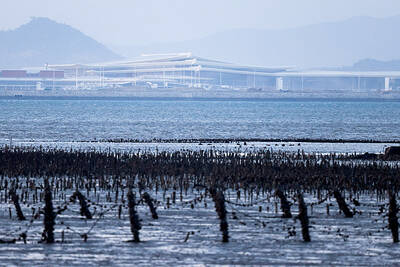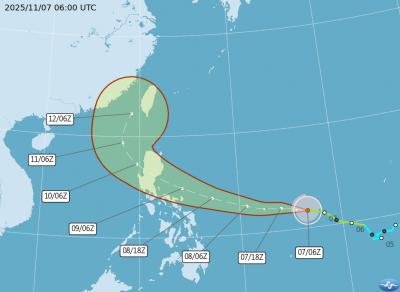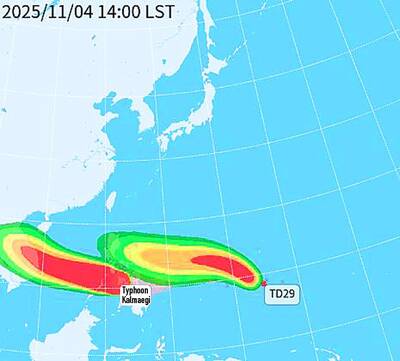Civic groups yesterday called on the Environmental Protection Administration (EPA) to reject construction plans for the coal-fired Shenao Power Plant (深澳電廠), saying the project would worsen the air quality in the north.
Taiwan Power Co (Taipower) plans to install two ultra-supercritical coal-fired generators with 600 megawatts of capacity each at the plant in New Taipei City’s Rueifang District (瑞芳).
The EPA is to hold an environmental impact assessment (EIA) grand assembly tomorrow to review the project, after an EIA committee meeting on Jan. 29 advised the agency to either require the developer to conduct a new EIA or to approve the project after asking it to submit supplementary documentation.
The project passed an EIA in 2006, but the utility last year applied for an environmental impact difference review after making changes to the plan. However, many groups are calling it a new construction project, given that the plant stopped operations in 2007.
The government plans to reduce the percentage of the nation’s energy generated from coal to 30 percent from the current 45.4 percent by 2025, meaning that demand for coal-fired power is declining and the plant is unnecessary, Greenpeace Taiwan campaigner Lisa Tsai (蔡佩芸) told a news conference in Taipei.
To stabilize the power supply, the nation needs more energy-saving facilities and better management of power supply and demand, not another coal-fired power plant, Green Citizens’ Action Alliance deputy secretary-general Hung Shen-han (洪申翰) said.
The project’s breakwaters and coal delivery harbor would damage the habitats of algae and animals on the seabed, independent ecological researcher Liang Yi-shuo (梁珆碩) said, adding that the artificial structures would also ruin the northeastern region’s coastline and geological continuity.
Warm water discharged from the plant would also affect the coral reefs along Shenao Bay (深澳灣), he added.
“The New Taipei City Government is not opposed to the construction of a power plant, but it rejects the idea that Taipower regards coal-fired power as its only option,” the city’s Environmental Protection Department said in a statement.
The city’s efforts to improve air quality have proved fruitful, with its annual average concentration of PM2.5 — fine particulate matter measuring 2.5 micrometers or smaller — having decreased to 17.1 micrograms per cubic meter last year from 24.63 micrograms per cubic meter in 2013, the department said, adding the plant’s operation would offset its endeavor.
The utility should carefully reassess the viability of the project, given that it was launched about 10 years ago, when the nation had not yet established standards for PM2.5 and greenhouse emissions reduction, it said, urging the utility to conduct a new EIA and adopt cleaner energy generation methods.

UNILATERAL MOVES: Officials have raised concerns that Beijing could try to exert economic control over Kinmen in a key development plan next year The Civil Aviation Administration (CAA) yesterday said that China has so far failed to provide any information about a new airport expected to open next year that is less than 10km from a Taiwanese airport, raising flight safety concerns. Xiamen Xiangan International Airport is only about 3km at its closest point from the islands in Kinmen County — the scene of on-off fighting during the Cold War — and construction work can be seen and heard clearly from the Taiwan side. In a written statement sent to Reuters, the CAA said that airports close to each other need detailed advanced

Tropical Storm Fung-Wong would likely strengthen into a typhoon later today as it continues moving westward across the Pacific before heading in Taiwan’s direction next week, the Central Weather Administration (CWA) said. As of 8am, Fung-Wong was about 2,190km east-southeast of Cape Oluanpi (鵝鑾鼻), Taiwan’s southernmost point, moving westward at 25kph and possibly accelerating to 31kph, CWA data showed. The tropical storm is currently over waters east of the Philippines and still far from Taiwan, CWA forecaster Tseng Chao-cheng (曾昭誠) said, adding that it could likely strengthen into a typhoon later in the day. It is forecast to reach the South China Sea

Almost a quarter of volunteer soldiers who signed up from 2021 to last year have sought early discharge, the Legislative Yuan’s Budget Center said in a report. The report said that 12,884 of 52,674 people who volunteered in the period had sought an early exit from the military, returning NT$895.96 million (US$28.86 million) to the government. In 2021, there was a 105.34 percent rise in the volunteer recruitment rate, but the number has steadily declined since then, missing recruitment targets, the Chinese-language United Daily News said, citing the report. In 2021, only 521 volunteers dropped out of the military, the report said, citing

WEATHER Typhoon forming: CWA A tropical depression is expected to form into a typhoon as early as today, the Central Weather Administration (CWA) said yesterday, adding that the storm’s path remains uncertain. Before the weekend, it would move toward the Philippines, the agency said. Some time around Monday next week, it might reach a turning point, either veering north toward waters east of Taiwan or continuing westward across the Philippines, the CWA said. Meanwhile, the eye of Typhoon Kalmaegi was 1,310km south-southeast of Oluanpi (鵝鑾鼻), Taiwan’s southernmost point, as of 2am yesterday, it said. The storm is forecast to move through central